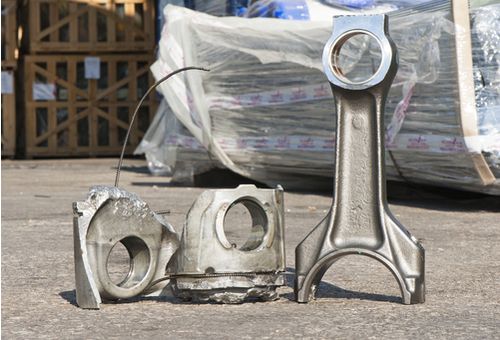
In Part 1 of this series of articles, we discussed some common causes of piston fractures in diesel engines, most of which are relatively easy to identify. However, in this article, we will discuss a few “exotic” causes of piston fractures, the root causes of which are often the direct results of oversights and avoidable mistakes made by non-professional engine rebuilders.
In fact, as diesel technicians, we are often presented with diesel engines that have failed (again) because of failures by non-professionals to detect and correct underlying defects in parts like pistons, gaskets, connecting rods, and valves. Moreover, we often see engine failures caused by the effects of improper or sloppy assembly procedures or the use of cheap, unbranded aftermarket parts with unknown and/or uncertain origins. Let us start with-
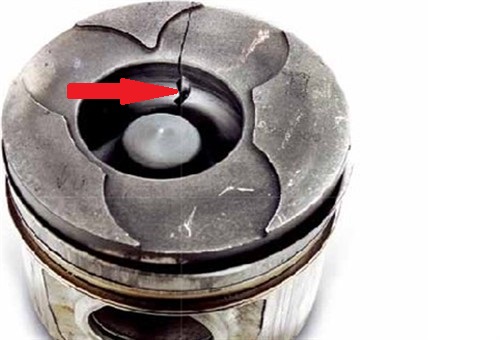
Image source: https://www.memoparts.com/img/cms/Documents/Piston%20Failue.pdf
In this example, the piston shows a crack that begins at the point indicated by the arrow, and which extends right through the piston crown, down to the gudgeon pin bore (not shown here). Nonetheless, the most important aspect of this failure is the small hole indicated by the arrow- this is a hole that (in this example) extends through the crown to emerge below the oil control ring, and which was caused by an abnormal combustion process over an extended period.
We have discussed abnormal combustion in diesel engines in a previous article, but in that article, we focused on piston failures as a result of pistons overheating as a result of abnormal combustion processes. While the causes of abnormal combustion in both direct and pre-chamber diesel engines are largely similar, what happens to pistons in diesel engines as a result of abnormal combustion largely depends on the piston design. Here is why piston design matters-
We know that the function of pre-combustion chambers is to direct the nascent combustion flame into the combustion chamber proper in a manner that induces a violent swirling motion in the air/fuel charge to improve combustion. In pistons with small-diameter, but deep bowls in their crowns, such as the example shown here, the high heat of the nascent combustion flame is always concentrated on a small area of the bowl's wall. Provided that the pre-combustion chamber directs or “focuses” the nascent combustion flame properly, the piston’s overall design allows for the efficient dissipation of excess heat at this spot.
However, in cases where the pre-combustion chamber is damaged, cracked, and/or deformed, the nascent combustion flame takes on the appearance of a blowtorch flame that concentrates its heat on an abnormally small area of the bowl's wall, which creates a small area in the piston crown that expands beyond its elastic limits.
Many variable factors come into play at this point. For instance, if the engine is operated at a steady speed and load, the affected piston might very well withstand the abnormal combustion process for an appreciable period without failing.
However, it is when the affected piston cools down that the real damage occurs. Here is what happens-
Since a small area of the piston's bowl had expanded beyond its elastic limits, some of the expanded material had been displaced into adjacent areas of the bowl’s wall. Thus, when the piston cools down and starts to contract, the area from which material had been displaced is less dense than the areas that surround it.
The practical effect of this is that the piston contracts unevenly, which causes stress fractures to develop, and because stress fracture lines usually radiate outward from the point where the piston is the least dense, one of two things can happen. The first is that several stress fractures develop radially from the least-dense point, or one major fracture occurs where the overall structure of the piston crown is the weakest.
However, in the example shown here, the engine was running at high speed while towing a boat. Thus, since the stress fracture occurred while the piston was hot, combustion pressure had blown the localised hotspot out of the crack in the piston crown at the point of least resistance, thereby creating the “blow-hole”.
In this instance, the vehicle's driver switched off the engine immediately after the affected cylinder had lost its compression through the hole, but not all drivers always act as quickly or decisively. In such cases, the superheated blow-by gas in an engine that keeps on running (after a stress fracture had occurred in a piston) can distort the gudgeon pin to the point where it seizes in its bore. If the engine is running at even a moderate speed at this point, the piston can disintegrate explosively.
Note that while defective or damaged pre-combustion chambers is a common cause of this type of failure, there are-
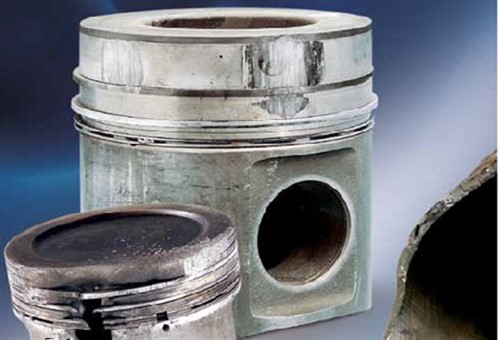
Image source: https://www.memoparts.com/img/cms/Documents/Piston%20Failue.pdf
The phrase “unsuitable piston design” covers a multitude of sins, including but limited to piston diameter, compression height, gudgeon pin diameter, ring groove height/depth/ placement, cooling oil galleries (or not) as the case may be, and even anti-friction coatings (or not), again, as the case may be.
While few professional engine rebuilders will ever get these aspects of piston design wrong, many, if not most non-professional rebuilders often fail to consider the fact that the pistons in diesel engines are critically important components of the overall emission control system on their engines.
As a practical matter, the efficiency of combustion processes on diesel engines is as much a function of how well the air and fuel mixes, as it is a function of the design of the pistons. We need not delve into the complex physical relationship between piston designs and combustion efficiencies here, but suffice to say that in all commercially available diesel engines in use today, emissions regulations are the principal driving force that determines the design of pistons.
We can fill several volumes on this topic but in the interest of brevity, we will just say -
To understand how this works, let us consider the image at the start of this section. In this example, the pistons exhibit score marks that are, for the most part, concentrated in the area above the first compression ring, while the rest of the pistons appear to be undamaged. Therefore, we can conclude that only the piston crowns have expanded excessively as the result of a problem that did not affect the rest of the pistons’ structures.
Moreover, since the diameter of the piston crown is significantly smaller than the piston’s diameter around the skirt, the cause of the excessive expansion of the crowns must have been an extreme and highly localised source of heat that affected only the crowns of the pistons, while leaving the rest of the pistons unaffected.
In this case, the heat source was an abnormal combustion process, but not as the result of an air/fuel mixture problem. In this case, pistons that were designed for the wrong set of emissions regulations caused the problem. Let us discuss this in some detail by using a practical example of how the design of a piston affects exhaust emissions-
Since the placement and design of bowls in diesel pistons are optimised to improve combustion, the design and placement of these bowls can also be used to change, improve, or otherwise alter the characteristics of the combustion process. However, while optimising existing piston designs to improve combustion is vastly more cost effective than designing new bespoke pistons from the ground up, this method does have some serious drawbacks. For instance, greatly improving the efficiency of the combustion process has both increased combustion temperatures and increased rates of NOx (Oxides of nitrogen) as corollaries, meaning that increasingly complex, heavy, and expensive exhaust after treatments become necessary to counter the effects of increased combustion efficiencies.
Therefore, engine designers optimise existing piston designs only to the point where the improved design produces combustion efficiencies that meet the absolute minimum requirements of whatever version of emissions regulations are in force at the time, and it is at his point where inexperienced engine rebuilders often get things wrong.
In the present example, the bowls in the example piston crowns were designed to meet Euro 3 emissions standards, so their bowls measured 77 mm across. However, when the engine was rebuilt the non-professional engine rebuilder used pistons intended to satisfy Euro 4 standards, which required higher combustion temperatures through using piston bowls that were only 75mm in diameter.
Since the old and new pistons were identical in all respects except for the diameter of the bowls, this non-professional rebuilder could perhaps be forgiven for not noticing the 2mm difference in the bowl diameters. Nonetheless, this difference had predictable results- the pre-combustion chambers now directed the combustion flame at the very edge of the piston bowls instead of into the deepest part of the bowls.
This caused severe overheating of the bowls' edges, which produced glow ignition conditions because of the localised hotspots. The glow ignition, in turn, caused uncontrolled combustion early in the intake stroke, which, in its turn, caused the combustion flame to contact the tops of the piston crowns and the cylinder walls directly. If this engine had not started to smoke excessively after only about 300km of driving with the new pistons, the pistons might have overheated to the point where they would have seized over larger areas of their surface.
This particular engine was salvageable, and a professional engine rebuilder could identify the root cause of the abnormal combustion. However, in many instances where non-professional rebuilders ignore one or more specific piston design requirements, pistons are frequently damaged to the point where it is impossible to relate the engine failure to a possible piston design-related problem.
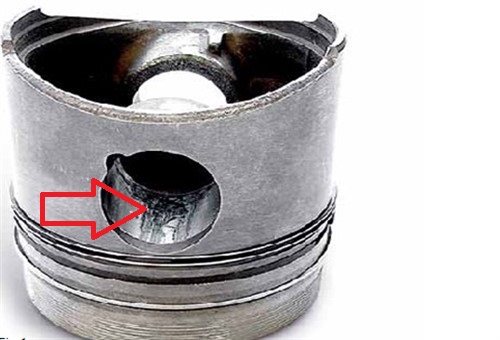
Image source: https://www.memoparts.com/img/cms/Documents/Piston%20Failue.pdf
This image shows an example of a piston in which the gudgeon pin had seized (indicated with the red arrow) within seconds after the first start-up of a newly rebuilt engine. Note the complete absence of wear marks anywhere on the piston- this shows that the gudgeon pin had seized almost immediately after start-up.
While there are several possible causes for gudgeon pins to seize in their bores, seizures that occur almost immediately after a newly rebuilt diesel engine starts for the first time typically has only two causes. The first cause is a lack of lubrication during assembly of the engine, and the second cause involves improper fitment of the connecting rods on engines with shrink-fit small ends.
As a practical matter, the small ends of diesel connecting rods are a lot bigger and wider than the small ends of petrol connecting rods. This means that it takes a great deal of heat applied over an extended period to expand a diesel small-end to the point where the gudgeon pin slides into position- even if it is lubricated before insertion.
As all professional diesel engine rebuilders know, the best thing to do after a gudgeon pin had been inserted into a hot connecting rod is to NOT move the connecting rod back and forth to check if the pin moves freely in its bore. In fact, it should not move freely because the gudgeon pin had absorbed most of the heat from the connecting rod, thus expanding it significantly. Therefore, the only time to check/verify this movement is after the piston/connecting rod had cooled down completely. Moving the connecting rod while the assembly is still hot causes severe damage to the pin bores if the gudgeon pin is rotated forcefully (in its bore) while in an expanded state.
As shown in this example, the forced movement had removed material from the surface of the piston pin bore, which effectively eliminated the required clearance between the pin and the bore surface. In this particular instance, the gudgeon pins on all four pistons seized within ten or so seconds of the first start-up, which prevented the pistons, gudgeon pins, and possibly the connecting rods from breaking apart- which would have happened had the engine been running at even a moderate speed, which brings us to the advisability (or otherwise) of-
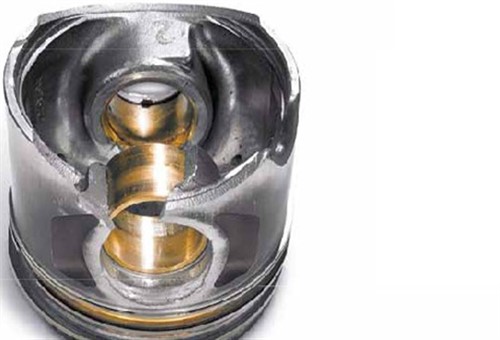
Image source: https://www.memoparts.com/img/cms/Documents/Piston%20Failue.pdf
Although diesel engines in light vehicles have enormous structural strength and rigidity, the same is not always true for individual components like crankshafts and connecting rods. In practice, almost any event that involves piston seizures, mechanical contact between pistons and valves, or even mild hydro-locking has the potential to bend, deform, or break a connecting rod or crankshaft.
Since rebuilding or reconditioning a diesel engine is usually enormously expensive, many customers, and especially customers who rebuild their engines on a DIY basis, often choose to reuse crankshafts and/or connecting rods without verifying that these components are in fact, usable. In practice, connecting rods can bend even under operating conditions that do not involve severe impact forces; just excessive clearances in big end and/or small end bearings/bushes can eventually force the small end out of alignment with the big end. In most cases, these misalignments are small and are easy to correct by resizing and honing both bearing journals on specialised machines.
However, since allowable misalignments of big-, and small ends are typically limited to a few hundredths of a millimetre, many non-professional engine rebuilders press severely misaligned connecting rods into service in rebuilt engines, simply because the connecting rods are not visibly bent or deformed. Note that in this context, a deviation of 7 to 10 hundredths of a millimetre between the axes of the big and small ends would count as “severely misaligned”.
Moreover, the added friction that this level of misalignment causes will typically not be noticed when the engine rebuilder manually rotates the engine during the assembly process, meaning that these kinds of defects often go undetected during an engine rebuild, and therefore, the effects of deformed connecting rods usually only become apparent after the engine had been in use for some time. Of course, how long an engine runs with deformed connecting rods depends entirely on the degree to which the connecting rods are bent, but even under normal operating conditions, such engines typically fail within a few hundred kilometres of use.
The image at the top of this section illustrates the most common effect of bent connecting rods in diesel engines. In this example, uneven loads caused the gudgeon pin to crack, which set up vibrations in the piston that were severe enough to initiate a stress fracture through the gudgeon pin boss. Consider the image below-
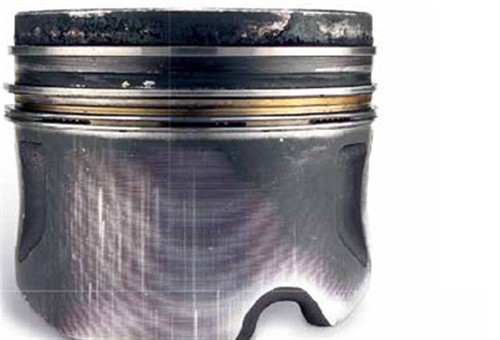
Image source: https://www.memoparts.com/img/cms/Documents/Piston%20Failue.pdf
In this view of the same piston as above, polarised light shone on the piston skirt reveals the radial pattern of stress lines that resulted from the unequal load placed on the piston by the deformed connecting rod. This kind of stress pattern is a defining characteristic of pistons that operate under unequal loads, but apart from crooked connecting rods, other possible causes of this condition could include one or more of the following-
Note, though, that using misaligned connecting rods do not always result in piston fractures. In some engines, marginally misaligned connecting rods cause pistons to follow a kind of pendulum motion, which can force gudgeon pins to knock one or both circlips out of their grooves.
In these cases, the dislodged circlips usually become trapped between the piston skirt and the cylinder wall, where they scratch deep furrows into both the piston skirt and the cylinder wall. In some cases, parts of the circlips can migrate into the ring zone where they can cause severe damage to one or more rings, with ring fractures being common results, which leaves us with this-
We hope that these articles have given you some new insights into why pistons in diesel engines fail in the ways they do. In the real world, though, secondary effects often mask, obscure, or erase evidence of the root cause of the failure, and in these cases, knowing how a particular failure might have originated is often the only way to diagnose the most likely cause(s) of the problem.
In fact, catastrophic diesel engine failures are sometimes so destructive that their possible or most likely causes can only be determined by subjecting fragments of pistons, cylinder liners, crankshafts, and connecting rods to advanced metallurgical analyses in specialised laboratories.
Fortunately, for us as ordinary technicians, though, we do not see those kinds of engine failures very often, so in theory, most of us should be able to diagnose most diesel engine failures relatively easily if we know what to look for. So are you up for the challenge of diagnosing the cause(s) of the next diesel engine failure that comes your way?